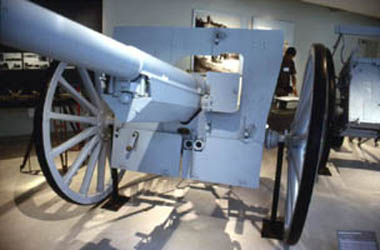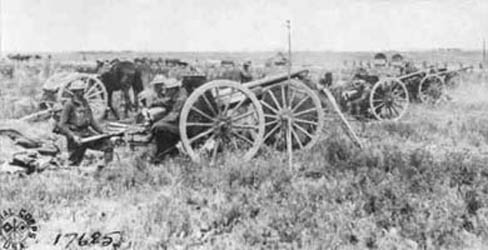Le Fabuleux 75 mm
Le canon de campagne Mle.1897, conçu à la toute fin du XIXe siècle, occupe une place unique dans l’histoire de l’artillerie: il fut le premier canon équipé d’un mécanisme de compensation du recul. Les premières unités en furent équipées à partir de 1898, et au début de la Grande Guerre, il constituait le principal canon de campagne de l’armée française. L’appellation courante de Puteaux Mle.1897 n’est pas tout à fait exacte puisque ce canon fut produit dans plusieurs usines, dont Schneider. Le «soixante-quinze» ou «75» resta longtemps en service: les paras français et les troupes polonaises l’utilisaient encore au cours de la Seconde Guerre mondiale. Dans l’armée polonaise, le canon avait pour désignation «75mm Armata wz.1897».
The field gun Mod.1897, conceived at the any end of the XIXth century, occupies a single place in the history of artillery: it was the first gun equipped with a recoil mechanism. The first units were equipped with it as from 1898, and at the beginning of the Great War, it constituted the principal field gun of the French Army. The current name of Puteaux Mod.1897 is not completely exact since this gun was produced in several factories, of which Schneider. The “seventy-five” or “75” remained a long time in service: the French paras and the Polish troops still used it during the Second world war. In the Polish army, the gun had as a designation “75mm Armata wz.1897”.
 |
Le Fabuleux 75mm |
src: Wikipéda
|
Au moment de sa conception, le canon français
se distinguait par un certain nombre d’innovations. En plus d’un
système de compensation du recul, il était également
pourvu d’un bloc-culasse à vis excentrée. Grâce
à ce dispositif, la cadence de tir était suffisamment
élevée même pour les standards de la Seconde Guerre
mondiale. Un vaste bouclier pourvu d’une ouverture pour le dispositif
de pointage protégeait les servants contre les éclats
d’obus. Le train de roulement était fait de roues de bois.
En 1933, certains canons furent modernisés par l’ajout
de roues en acier munies de pneus, et le bouclier fut abaissé.
Un système de pointage à collimateur fut également
installé. Même si les chars n’existaient pas encore
au moment de sa mise au point, le 75 se comporta bien en tant que canon
antichar. Il pouvait pénétrer 90mm de blindage à
100 mètres.
At the time of its design, the French gun was characterized by a certain number of innovations. In addition to one recoil system, it was also equipped with a block-cylinder head for offset screw. Thanks to this device, the rate of fire was sufficiently high even for the standards of the Second world war. A vast shield equipped with an opening for the device of pointing protected gunners against the glares. The running-gear was made wheels of wood. In 1933, certain guns were modernized by the addition of steel wheels provided with tires, and the shield was lowered. An aiming system with collimator was also installed. Even if the tanks did not exist yet at the time of its development, the 75 behaved well as an anti-tank gun. It could penetrate 90mm of shielding at 100 m.
 |
Le Fabuleux 75mm
en action avec son caisson à munitions |
The
Fabulous 75mm in action with its ammunition box |
src:L'uniforme
et les Armes des Soldats de la Guerre 1914-1918 tome 2, L. &
F. Funcken, Ed. Casterman |
| Data | |
| General | |
|
7 - 4-6 horses or 1 tractor
- +21000 (1897-1940?) 75 mm / 2.95 in (high-explosive, anti-tank and shrapnel) |
|
| Dimensions | |
| 1190 kg - 5.97-7.25 kg - 2.72 mm - 4.54 m | |
| Fire field | |
| -11° to +18° - 6° | |
| Performances | |
| 15/min - 529 m/s - 11000 m - 7000 m |
|
 |
Le Fabuleux 75mm
fut aussi utilisé par les autres pays alliés; ici
les le Corps expéditionnaire américain en France. |
The
Fabulous 75mm was also used by the other Allies countries; here
the American Task force in France. |
src: Lemaire Soft
|
Drawings |
-
L'Uniforme et les Armes des Soldats de la Guerre 1914-1918 , Tome 2, Ed. Casterman